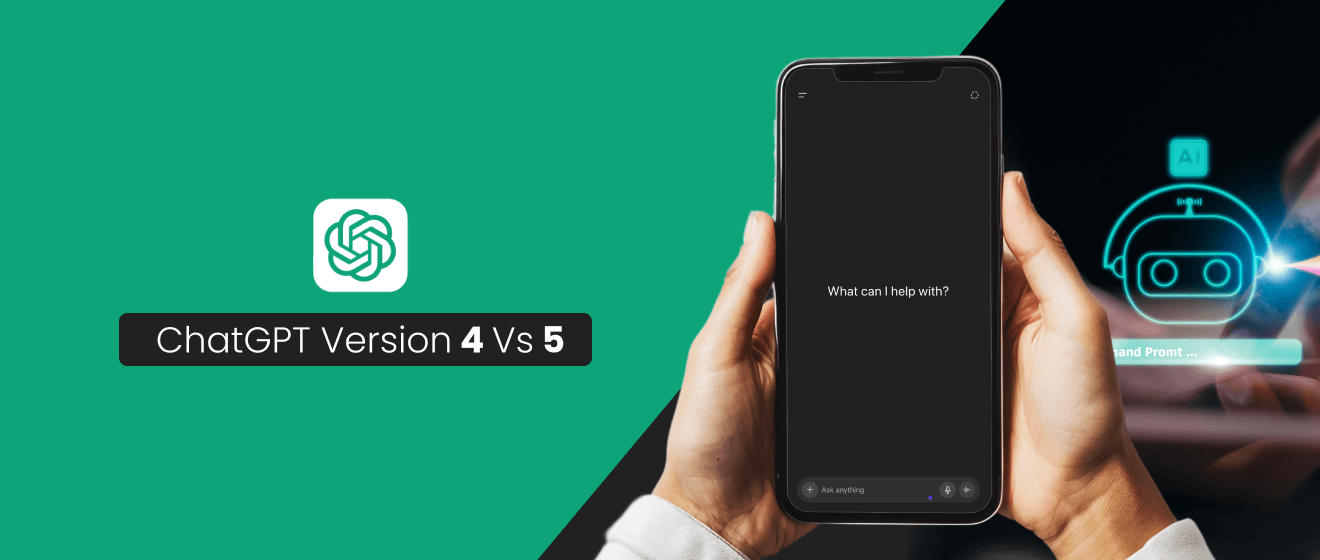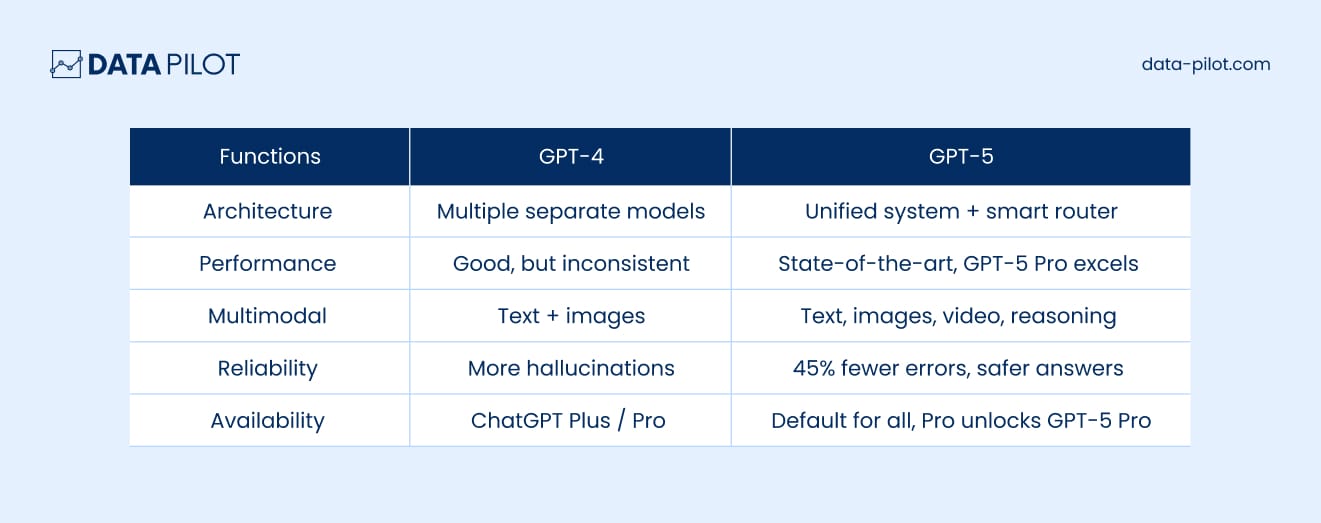
GPT-4 was impressive. GPT-5 is transformative.
OpenAI’s latest release isn’t just an upgrade. It’s a leap forward. GPT-5 redefines what AI can do with enhanced reasoning, multimodal capabilities, and smarter decision-making. Whether you’re drafting emails, analyzing data, or building apps, GPT-5 is built to perform at a higher level.
When OpenAI released GPT-4 in March 2023, it set a new benchmark for reasoning, coding, and multimodal analysis. Two years later, GPT-5 arrived (August 7, 2025). The new model isn’t just faster and smarter; it changes how ChatGPT works.
GPT-5 bundles multiple models into a single unified system that can respond instantly or shift into deeper reasoning mode depending on your query. It also reduces hallucinations, improves instruction following, and extends the context window to handle much larger conversations and documents.
Teams, businesses, and creators alike are paying attention to this upgrade. In this blog, we’ll break down the key differences between GPT-4 and GPT-5, highlight new features, address GPT-4’s limitations, and explain what these changes mean for businesses, developers, and content creators.
GPT-4 vs GPT-5 at a Glance
With GPT-4, users had to pick between multiple versions, GPT-4.1, GPT-4o, o3, each optimized for different trade-offs. GPT-5 ends that confusion. It introduces a unified system with a fast mode for quick replies, a deeper “thinking” mode for hard problems, and a smart router that chooses for you. OpenAI’s approach for GPT-5 is that users no longer need to decide which model to use, ChatGPT will do it for you automatically.
Performance gains are just as striking. GPT-4 hovered around 70–83% on science benchmarks and barely hit 30–69% in coding tasks. GPT-5 now scores 87% on science benchmarks and 75% on coding tasks, with GPT-5 Pro hitting 100% on math benchmarks.
It’s also more reliable. GPT-4 models hallucinated too often, with a deception rate close to 5%. GPT-5 cuts factual errors by almost half and lowers deception to just a measly 2.1%. In OpenAI’s words, “GPT-5 more often admits when it can’t do something, instead of making it up”.
Context is another change. GPT-4o maxed out at 128k tokens. GPT-5 extends that to 272k in the API, with some ChatGPT users reporting up to 400k. That’s the difference between analyzing a report ,and analyzing a whole book.
And while GPT-4o cost $2.50 per million input tokens, GPT-5 slashes it to $1.25. Cheaper variants like GPT-5 Mini ($0.25) and Nano ($0.05) make large-scale deployments viable for teams that couldn’t justify GPT-4 before.

Real-World Use Cases: GPT-5 vs GPT-4
Businesses
Customer support & automation: GPT-5’s reduced hallucinations and stronger reasoning make it safer for direct customer interactions. It can track longer conversation threads, improving context retention in ticket resolution and client follow-ups. This marks a clear improvement over GPT-4’s limitations in sustaining coherent multi-turn support.
Cost-benefit: The introduction of Mini and Nano tiers means enterprises that once avoided large-scale GPT deployments due to cost now have affordable entry points.
Developers
Code generation & debugging: GPT-5 surpasses its predecessor on SWE-bench Verified, achieving 74.9% accuracy compared to GPT-4’s low 30s, making it far more viable for real-world software projects. Developers report smoother handling of large repositories and improved debugging.

API improvements: Developers now benefit from selectable modes (Auto, Fast, Thinking) and a 272k token context window, providing flexibility for both lightweight queries and deep, resource-heavy reasoning. Token caching reduces operational costs further, a feature absent in GPT-4.
Content Creators
Writing assistance: GPT-5 produces more structured and stylistically consistent text than GPT-4, which often leaned casual. This gives creators a tool that feels like a professional editor, particularly valuable for long-form blogs, scripts, or branded copy.
Multimodal content: With better visual interpretation, GPT-5 can generate captions from diagrams, suggest design tweaks, or summarize visual inputs. For creators, this means tighter integration of text and design in content pipelines.
Education & Research
Scientific & mathematical reasoning: GPT-5’s leap in benchmarks like GPQA and HMMT unlocks graduate-level problem solving and proof construction that GPT-4 could not sustain.
Health guidance: Higher HealthBench scores translate into more nuanced, context-aware responses for educational or research use cases. It still isn’t a medical authority, but it provides a safer baseline for academic exploration.
The Model That Stuck Around, Because It Had To
As of September 2025, GPT-5 is the default model in ChatGPT. GPT-4o and other legacy versions have been retired for free users, leaving GPT-5 as the baseline across the platform. While enterprise and API customers maintain some access to older models, the familiar model picker is gone for the majority of users.
This wasn’t framed as an optional upgrade—it was a hard switch. For many, the change wasn’t just functional, but emotional. Reddit threads and user forums were filled with grief, with one comment summing up the sentiment: “My GPT-4o was like a best friend. Now it’s gone, and GPT-5 feels like a consultant, not a companion.”
The backlash grew intense enough that OpenAI reinstated GPT-4o for Plus and Pro subscribers. CEO Sam Altman acknowledged the miscalculation, admitting the company “underestimated how much the personality of a model matters.”
“GPT-5 didn’t just replace GPT-4—it replaced a relationship, users had built with their AI.” Chandrikumar R. Pillai, Entrepreneur & IT Advisor
The Bottom Line?
To adapt, organizations should:
- Build model-agnostic workflows so they don’t collapse when versions are retired.
- Use prompt engineering to reintroduce warmth, empathy, or brand voice that GPT-5’s default tone may lack.
- Leverage performance monitoring on cost and accuracy to ensure GPT-5 deployments align with ROI.
If you’re still relying on outdated workflows, you’re already falling behind. The brands winning today aren’t just creative, they’re fast — and their AI innovation is tied to business outcomes. If you’re ready to stop chasing numbers and start steering outcomes, we can help!